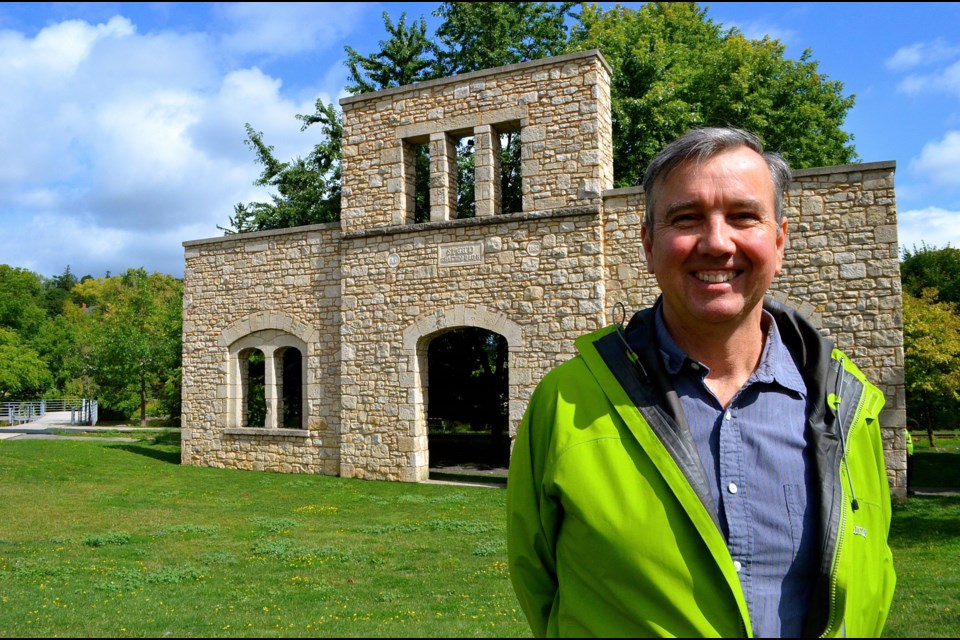The Speed Skating Rink near the corner of Macdonell and Woolwich streets was considered the most beautiful arena in the province when it was built in 1882 but its short-lived use and fiery end have rendered it a monument to lost possibility.
“It was a stunning building in its time,” said Ken Irvine, education coordinator for Guelph Museums. “Unfortunately, it was only in operation as an arena for about five years.”
The commercial demand to transport people and products by rail to and from the growing industrial town took priority over the recreational needs of the community.
“It was purchased by the GJR (Guelph Junction Railway) in 1888 and modified to permit the construction of railway tracks behind it,” said Guelph historian Cameron Shelley.
The railway tracks the GJR installed still run along the river behind the rink’s stone façade.
“When the railway came through, they needed the track so, they had to clip off the end of the building and it was no longer functional as an arena,” said Irvine.
It was a business decision that dashed the hopes of athletes and artisans alike who aspired to make Guelph and its celebrated Speed Skating Rink, a centre for sports and culture.
“It had a hard ice surface plus viewing galleries and separate rooms,” said Shelley. “The acoustics inside were pretty good, so many concerts were held there as well.”
Skating and concerts were only two of its intended uses.
“It was sort of a recreation complex,” said Irvine. “It was a skating rink, but they were also going to use it as a bowling alley, to do curling and have tennis, lawn bowling and croquet outside. They were going to utilize the area around it as a park and probably do canoe rides on the river.”
It was designed by John Day, a prolific Guelph builder and architect who designed a number of the city’s architectural landmarks including the Petrie Block and the Manor, former home of Guelph mayor George Sleeman.
“John Day was a noted architect in the Guelph area,” said Irvine. “He did a lot in Guelph so, it was a well-designed, well-built and attractive building that we, unfortunately lost.”
Despite it being an architectural jewel in the Royal City’s crown during the 1880s there are relatively few historical records of the Speed Skating Rink operating as an arena. A description of the arena during the five or six years it was in operation can be found on the Guelph Arts Council website.
“The Speed Skating Rink was the scene of band concerts and choral presentations as well as pleasure skating. For the skating, an orchestra assembled on the ornate mezzanine balcony overlooking the ice and played waltzes as bonnet-bedecked ladies in ankle-length dresses glided sedately around the rink on the arms of men dressed in suits and ties. Very elegant and dignified for those days.”
There are no records of it being used by the community for any of its intended purposes after 1888 but Irvine found a story of it housing soldiers en route to Europe during the First World War.
“People were billeted here inside the building while they did some training and were recruited at city hall,” Irvine said. “While they were in the building, they carved their names on the immense wooden beams inside. The names of soldiers who never came back were carved in the wood and lost forever. That is a chunk of history we can never get back.”
For nearly a century it was used as a warehouse and was leased to the Canadian Pacific Railway as a freight shed.
“After the CPR lease was up in 1987, advocates got it designated as a historic site and it was supposed to be incorporated into the River Run Centre but burned down in 1991,” said Shelley. “The facade was later reassembled as a folly in John Galt Park.”
The cause of the fire was never determined but arson was suspected. Many rumours have circulated, but it is commonly believed it was kids playing with matches inside.
“It had been vacant and used for storage,” said Irvine. “It wasn’t well sealed up and people could get in.”
The fire destroyed all of the wooden structure leaving three of the original stone walls standing. They were eventually taken down to make room for construction of a brand-new performing arts facility, The River Run Centre, that began in 1995.
“They took it down and stored the stone then rebuilt the façade as it is now,” said Irvine. “The arches and window frames have been reproduced pretty well but if you see it in the original pictures, it’s not exactly like it was. It would have been a totally different look if we had this building instead of the River Run.”


